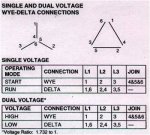moonshineJ
Member
- Location
- USA
There is a 3-phase motor with 6 leads; U1, V1, W1, U2, V2, W2. It can be connected either for low voltage (delta), or for high voltage, 450 VAC (wye).
None of leads has any identification other than colors (black, brown, red, yellow, blue, and green)...no labels with U1, W2, etc. No numbers, like 1, 2, 3, etc.
The easy part is that one can easily identify 3 pairs of windings with an ohmmeter. How can 1s and 2s be identified?
I saw that some Yahoo-types advise to connect U, V, W arbitrarily together (for wye) and hook up L1, L2, L3 to the remaining ends of U, V, W and then bump test it, while observing if motor will run. Obviously, it's a bad idea, as polarity of one winding can be different from other two...best case scenario - this will blow fuses.
I did some more research and found some more scientific approaches:
a) "I've heard once that you have to connect a DC voltage (battery 12VDC) to one coil. You then have to release the voltage while measuring on another winding. The counter EMF will say you how the other coils is connected. Repeat this 3 times".
b) "Ring out one winding.
Attach a 9V battery to the ends. NOTE the polarity of the battery. Using an analog meter ring out the other 2 windings, the meter deflection should be positive if not switch meter leads over. Now label the 2 leads you have rung out with the red or positive meter lead A1 and B1. Now connect the battery to the A1 and negative to A2 Then put your meter across the winding the battery WAS connected to and check for positive deflection of the meter. Then all you do is switch ends on the last winding so the wire that was connected to the the negative of the battery is now C1
So now we know which group is the beginning and end of each winding without running the risk of getting the ends mixed up".
I did some research on color coding - if it's possible to determine U1, V1, W1, U2, V2, W2 by color of motor leads. It turned out that these colors can be anything possible - which I know from my own experience (even if there were some solid standard for it, I would not take it for granted).
Is there some good reference for this procedure?
Are there other ways to do this check?
And last but not the least - what is the proper name for this check?
None of leads has any identification other than colors (black, brown, red, yellow, blue, and green)...no labels with U1, W2, etc. No numbers, like 1, 2, 3, etc.
The easy part is that one can easily identify 3 pairs of windings with an ohmmeter. How can 1s and 2s be identified?
I saw that some Yahoo-types advise to connect U, V, W arbitrarily together (for wye) and hook up L1, L2, L3 to the remaining ends of U, V, W and then bump test it, while observing if motor will run. Obviously, it's a bad idea, as polarity of one winding can be different from other two...best case scenario - this will blow fuses.
I did some more research and found some more scientific approaches:
a) "I've heard once that you have to connect a DC voltage (battery 12VDC) to one coil. You then have to release the voltage while measuring on another winding. The counter EMF will say you how the other coils is connected. Repeat this 3 times".
b) "Ring out one winding.
Attach a 9V battery to the ends. NOTE the polarity of the battery. Using an analog meter ring out the other 2 windings, the meter deflection should be positive if not switch meter leads over. Now label the 2 leads you have rung out with the red or positive meter lead A1 and B1. Now connect the battery to the A1 and negative to A2 Then put your meter across the winding the battery WAS connected to and check for positive deflection of the meter. Then all you do is switch ends on the last winding so the wire that was connected to the the negative of the battery is now C1
So now we know which group is the beginning and end of each winding without running the risk of getting the ends mixed up".
I did some research on color coding - if it's possible to determine U1, V1, W1, U2, V2, W2 by color of motor leads. It turned out that these colors can be anything possible - which I know from my own experience (even if there were some solid standard for it, I would not take it for granted).
Is there some good reference for this procedure?
Are there other ways to do this check?
And last but not the least - what is the proper name for this check?
Last edited:

